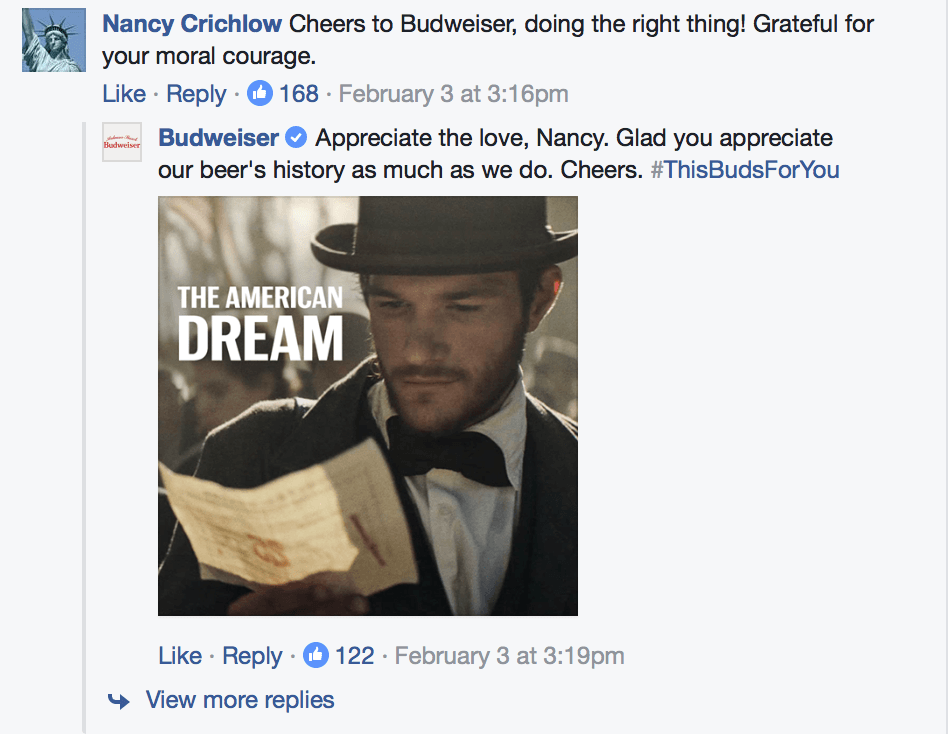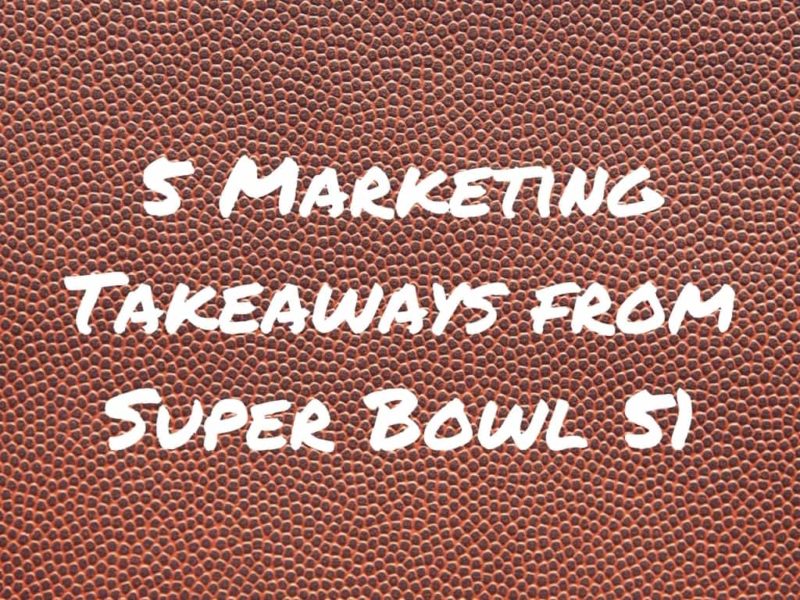What time does the Super Bowl start? Super Bowl 2018 starts at 6:30pm. Now that we’ve covered the question on everybody’s mind, let’s take a look back at the best Super Bowl ads of 2017…
Super Bowl 51 is over. What have we learned? It’s not over ’til it’s over?
Well, yes. The 4th quarter proved that. But we’ve also learned some valuable marketing lessons from the ads, the brands on social media and the halftime show.
Let’s relive the big game one more time. Here are five marketing takeaways from Super Bowl 51.
1. Connect with a Value
Taking a stand – especially when it comes to political issues – can be risky, but it can also be a powerful way to connect with your customers. During Super Bowl 51, a number of brands took a stand, including Coca Cola, Google, Audi, Budweiser, Airbnb and 84 Lumber.
Budweiser’s ad celebrates the company’s immigrant founder, Adolphus Busch. As fans shared support on Facebook and Twitter, the brand’s social media team responded to every post. The responses included personalized names and sentiments, showing the brand truly cared about connecting with fans.

Budweiser’s ad is subtle compared to 84 Lumber’s spot, which was originally rejected by Fox for being “too controversial.” The final version of the ad was the first 90 seconds of a story that runs five minutes and 45 seconds. The last few seconds directed viewers to a landing page where they could watch the rest of the story:
So many people visited 84 Lumber’s landing page during the big game that the site crashed. Clearly, the story resonated. In the end, 84 Lumber’s ad is about recruitment – but rather than investing in a Super Bowl commercial that said “come work for 84 Lumber,” the company chose instead to connect with viewers through a shared value (one of our 17 hacks for visual storytelling). Now, people who visit the landing page will have a stronger connection with the brand – and therefore will be more likely to fill out an application.
2. Be a Showstopper
Tide stopped the show with an ad that fit seamlessly into the broadcast. When Terry Bradshaw came back from a commercial break with a stain on his shirt, plenty of people in the Twitter-sphere thought the stain was real. But, turns out it was all part of Tide’s master plan.
Lady Gaga, a veteran showstopper, showed how it’s done during the Pepsi halftime show, incorporating drones, a roof jump and an epic mic drop (let’s be honest, it was really more of a mic spike) into her performance. The Pepsi halftime show gained higher ratings than the big game itself.
Fans who stuck around for the trophy presentation after New England’s stunning comeback were struck by one last showstopper – a spot from Hyundai that was shot and edited in just 48 minutes during the game. Hyundai and its agency Innocean surprised selective service members in Poland with a 360 degree live stadium experience – with their families sitting in the seats next to them. The spot was genuine and powerful – sure to stop any fan in their tracks.
3. Play Ball
During Super Bowl 51, many of the official sponsors weren’t afraid to play ball on social media, interacting with other brands.
Check out this exchange between Tide and Mr. Clean:
Hey @RealMrClean if you want to keep those tight pants stain free, we’ve got your back… The view is spectacular BTW! #SB51 #MrClean pic.twitter.com/NIvxKXgYDq
— Tide (@tide) February 6, 2017
And this one between Mr. Clean and TMobile:
@RealMrClean For someone so clean, that’s some dirty dancing for sure! #UnlimitedMoves #MrClean #SB51 pic.twitter.com/J0FIBCbDEm
— T-Mobile (@TMobile) February 6, 2017
Avocados from Mexico also got in on the action, weaving in its own campaign:
#AvoSecrets No. 443: #Guacamole has provided @tide with business since the beginning of time #BradshawStain #SB51 pic.twitter.com/m7PFxOSROV
— Avocados From Mexico (@AvosfromMexico) February 6, 2017
Poking fun of each other allowed each brand to get creative and promote its own message.
4. Follow Through
A number of brands made the most of their ad buys by creating supplemental content for social media and their websites, like the #AvoSecrets sweepstakes and Pepsi’s behind the scenes videos about the halftime show.
Get ready to this exclusive new look #BTS of @ladygaga rehearsing for #PepsiHalftime! pic.twitter.com/YHihjI9gW6
— Pepsi™ (@pepsi) January 31, 2017
But perhaps the most striking example is Airbnb. The brand followed through by attaching a bold promise to its campaign. During the Super Bowl, the company announced a plan to provide short-term housing for 100,000 people in need, and a commitment to donate $4 million to the International Rescue Committee over the next four years.
Our five-year goal is to make sure 100,000 people have short-term housing during urgent times.
Join us: https://t.co/gJ1MTGZZzh#weaccept pic.twitter.com/nHrCxcKado
— Airbnb (@Airbnb) February 6, 2017
5. Catch Their Attention
Content that stands out visually has incredible power to catch your fans’ attention, especially when they’re inundated with content. A handful of ads stood out during Super Bowl 51 because they were visually different from the rest.
LIFEWTR’s ad is bright and colorful with music by John Legend. The spot moves slowly compared to many of the other ads that try to pack a lot into 60 seconds, and feels like a breath of fresh air.
The stillness of Bai’s ad also presented a visual contrast with the other commercials. The ad starts with a few seconds of Christopher Walken staring at the camera (perhaps to give us all time to gasp with excitement at the sight of him). The visual simplicity of the spot (and its star) capture our attention long enough for us to catch the joke – he’s singing an N*Sync parody, “Bai Bai Bai.”
It’s A 10 Hair Care caught our attention with one of the most lighthearted political jabs of the evening. The ad was shot in black in white, was packed with absurd hairstyles, and started out with the line, “America, we’re in for at least four years of awful hair.”
The Bottom Line
We hope the biggest night in TV advertising will inspire your content marketing. Need some more ideas for how to win with visual storytelling? Check out our 17 visual storytelling hacks for 2017.




